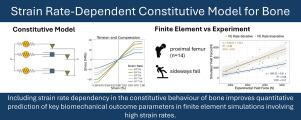应变率相关的骨非线性本构模型:从准静态到低冲击加载场景
IF 3.5
2区 医学
Q2 ENGINEERING, BIOMEDICAL
Journal of the Mechanical Behavior of Biomedical Materials
Pub Date : 2025-08-18
DOI:10.1016/j.jmbbm.2025.107157
引用次数: 0
摘要
上肢和下肢的骨质疏松性骨折通常是由站立高度坠落引起的,涉及相对较高的应变率。由于骨的本构模型缺乏应变率依赖性,用于骨折风险预测的骨有限元模型往往低估了这种低冲击跌落情景下的刚度和强度。本研究建立了一种适用于准静态实验试验、生理载荷和低冲击跌落的骨各向异性粘弹塑性损伤模型,涵盖8个数量级的应变速率。在准静态和高应变率条件下,对人类胫骨远端(n=25)和股骨近端(n=14)进行了单元素测试以及均匀有限元模拟,并根据文献值和实验测试进行了验证。该模型定性和定量地再现了实验观察到的在较高应变率下刚度和屈服应力的增加。在准静态条件下,高一致性相关系数(CCC)证实了实验和模拟的表观刚度(CCC=0.98)和屈服力(CCC=0.98)之间的良好一致性。对于涉及高应变率的模拟,当使用速率不敏感本构模型时,刚度(CCC=0.33)和屈服力(CCC=0.31)都被低估了。粘弹塑性模型的表观刚度估计过高(CCC=0.53),而屈服力与实验数据吻合较好(CCC=0.76)。总之,粘弹塑性本构模型适用于从准静态实验测试到低冲击跌落场景的应变率下的骨有限元分析,并大大改善了与骨折风险预测相关的生物力学结果参数的预测。本文章由计算机程序翻译,如有差异,请以英文原文为准。

Strain rate-dependent non-linear constitutive model of bone: From quasi-static to low-impact loading scenarios
Osteoporotic fractures at the upper and lower extremity are typically caused by falls from standing height involving relatively high strain rates. Finite element models of bone used for fracture risk prediction often underestimate both stiffness and strength in such low-impact fall scenarios due to the absence of strain rate dependency in constitutive models of bone.
In this study, an anisotropic viscoelastoplastic damage model for bone applicable for quasi-static experimental tests, physiological loading and low-impact fall scenarios covering eight orders of magnitude strain rate was developed. Single element tests, as well as homogenised finite element simulations of human distal tibiae (=25) and proximal femora (=14), were performed and validated against literature values and experimental tests performed under quasi-static and high strain rate conditions.
The model reproduces the experimentally observed increase in stiffness and yield stress at higher strain rates both qualitatively and quantitatively. Under quasi-static conditions, high concordance correlation coefficients () confirmed excellent agreement between experimental and simulated apparent stiffness (=0.98) and yield force (=0.98). For simulations involving high strain rates, both stiffness (=0.33) and yield force (=0.31) were underestimated when using a rate-insensitive constitutive model. With the viscoelastoplastic model, the apparent stiffness was overestimated (=0.53), while the yield force was in fair agreement with the experimental data (=0.76).
To conclude, the viscoelastoplastic constitutive model is applicable for finite element analysis involving bone at strain rates ranging from quasi-static experimental tests up to low-impact fall scenarios and substantially improves the prediction of biomechanical outcome parameters relevant for fracture risk prediction.
求助全文
通过发布文献求助,成功后即可免费获取论文全文。
去求助
来源期刊

Journal of the Mechanical Behavior of Biomedical Materials
工程技术-材料科学:生物材料
CiteScore
7.20
自引率
7.70%
发文量
505
审稿时长
46 days
期刊介绍:
The Journal of the Mechanical Behavior of Biomedical Materials is concerned with the mechanical deformation, damage and failure under applied forces, of biological material (at the tissue, cellular and molecular levels) and of biomaterials, i.e. those materials which are designed to mimic or replace biological materials.
The primary focus of the journal is the synthesis of materials science, biology, and medical and dental science. Reports of fundamental scientific investigations are welcome, as are articles concerned with the practical application of materials in medical devices. Both experimental and theoretical work is of interest; theoretical papers will normally include comparison of predictions with experimental data, though we recognize that this may not always be appropriate. The journal also publishes technical notes concerned with emerging experimental or theoretical techniques, letters to the editor and, by invitation, review articles and papers describing existing techniques for the benefit of an interdisciplinary readership.
 求助内容:
求助内容: 应助结果提醒方式:
应助结果提醒方式:


